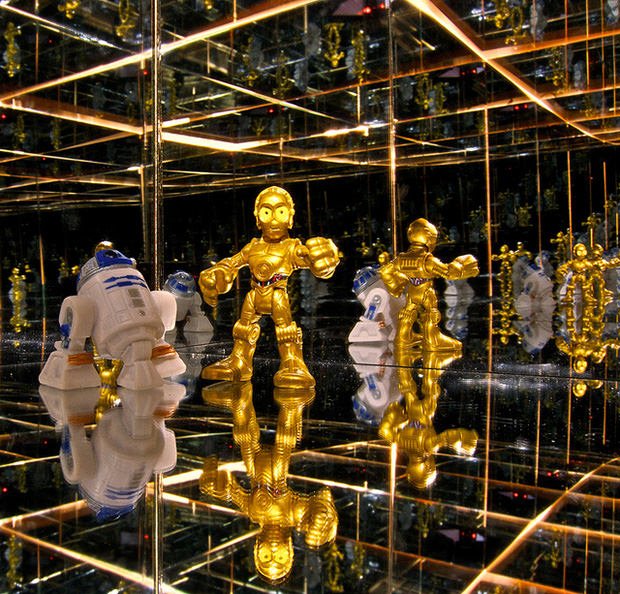Table of Contents (click to expand)
If you stepped inside a spherical mirror, you would see an infinitely magnified image of your head.
Most people love to stand between two parallel mirrors when they have the chance in a hotel hallway or bathroom. They can even do this in their own home, assuming they are resourceful enough to do so. The infinite amount of images that appear on the glassy surfaces is truly unsettling. Regardless of how unsettling it might be for an introvert to be in the same room as so many other ‘people’, the phenomenon is still puzzling for everyone else!

The science behind image formation from mirrors is quite developed and the reason for the infinite number of images seen on parallel-placed perpendicular mirrors is very well understood. Therefore, it is easy to imagine in our heads what it’s like to experience that, since technically we HAVE experienced it. However, can you guess what you’d see if you stepped into one giant spherical mirror?
The Difference Between Flat And Spherical Mirrors
The difference is borne of the fact that, in the case of a spherical mirror, there are no edges and therefore no boundaries to our field of vision. This means that light cannot avoid reflection from the mirror’s surface and has to reach our retinas eventually, no matter where it hit the mirror surface first. Keeping that in mind, let’s look at another important factor that affects the type of image formation – the source of light.
In parallel flat mirrors, the light from the light source strikes in a non-uniform manner. In the case of a spherical mirror ‘room’, a light source placed directly in the middle would illuminate the room evenly. Imagine such a light source floating right in the middle of the room, without any obstruction, such as our bodies, in its path. The room would be evenly lit and since all the light would be reflected back to the center, everything would be bright inside the room. In a more realistic scenario, since light loses a certain amount of energy with each reflection, the room would start absorbing radiation and heat up. If the point source was sufficiently powerful, the mirrors would heat up to such a degree that they would start melting. We probably wouldn’t want to be anywhere near that…

This is also why, if a light source is turned on for a certain amount of time and then switched off, the light wouldn’t be ‘trapped’. Its energy would be absorbed by the mirror in a fraction of a second, since that is enough time for millions and millions of such reflections. This small fact would prevent us from turning into kebabs if we stepped into that spherical room and decided to turn on the lights.
Now we can move on to understanding what you would actually see if you stepped inside a spherical mirror as tall as your bedroom walls.
Also Read: Why ‘Objects In The Mirror Are Closer Than They Appear’?
The View Inside
First, we’ll assume that your height is equal to the radius of the room, which means that your head is exactly at the center of the sphere if you are standing up straight. What you will see at that point is absolutely nothing, as there is no light source. To remedy that, imagine a point source of light directly above your head, which would give us the most easily explainable situation.
Interestingly, when that light source is switched on, all you would see is you! Since you are at the center of curvature of the sphere, the image from one half of the sphere would generate an image directly onto the surface of the other half. Due to this placement, the new image would be infinitely magnified, covering everything in your field of vision! You will essentially end up seeing an infinitely magnified head.

More interestingly, if you were to slowly crouch, your head would slowly move away from the center. Gradually, the magnification of your head would decrease and you would be able to make out a discernible shape directly overhead. The surroundings would still be out of focus, but the point directly overhead would look more and more like your head. When you are centimeters away from the surface, you would be able to see yourself both on the surface below you and the surface directly above you. Unfortunately, the surroundings would still look like a jumbled mess to our brains. To observe what that jumbled mess would look like, check this video:
One thing to note here is that the point source of light is continuously adding light energy into the room. If the rate of energy being added is more than the rate of absorption by our bodies, eyes and the surfaces of mirrors, the room would get brighter and brighter. To prevent that from happening and getting cooked, we would have to make sure that the light source isn’t emitting light faster than it can be lost. Although this would result in the room getting dimmer by the second, it is far better than the alternative.
Also, it is important to note that our eyes are limited in their ability to resolve objects. If an object is very close to our face, we wouldn’t even be able to make out different aspects of the image; therefore, there is no point in magnifying that image beyond a certain level.
Also Read: Where Does The Light Go When You Switch Off A Lamp Inside A Room?
The View Inside A Cube-Shaped Mirror Room
If a person built a whole room out of flat mirrors and stepped inside, the same rules for light energy absorption would apply. Additionally, the view would be more discernible and thus more awe-inspiring. If you are inside it, your view would be like a kaleidoscope view of yourself in all directions. The number of multiple reflections that you see would depend on the mirror reflectivity, which is finite. Fortunately, this can be easily captured by making a box out of smooth flat mirrors and then placing a camera and a light source inside the box.
Also Read: The Science Behind One-Way Mirrors: How Do They Work?

How well do you understand the article above!

